As race for coronavirus vaccine intensifies, Americans think back to Salk
by Heather Robinson

From The Jewish News Syndicate
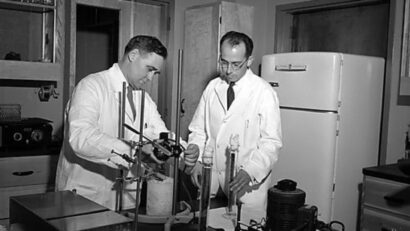
Peter Salk, son of Dr. Jonas Salk and an infectious-disease expert, believes his father’s legacy can guide modern medicine as it pertains to COVID-19.
Each year in the 1940s and ’50s, more than 15,000 Americans were paralyzed by polio and thousands died. The disease reached its peak in the United States in 1952, leaving 3,145 Americans dead and some 21,269 paralyzed. As with the country and world at this time struggling to deal with another deadly virus—SARS-CoV-2, more commonly referred to as COVID-19—methods to combat the contagion included quarantines, prevention efforts and the race for a vaccine.
Decades ago, in a nation struggling to deal with the scourge that came each summer to prey on America’s children, a champion emerged in the form of Dr. Jonas Salk, a soft-spoken American Jewish scientist at the University of Pittsburgh who developed the first, and ultimately most effective, vaccine to eradicate polio, a disease that had plagued humanity for millennia. Known for his dedication, brilliance and altruism, Salk and his work in the field became the stuff of legend. An official announcement of the vaccine’s safety and efficacy on April 12, 1955 catapulted him to international fame and enshrined him as a titan in the history of science and humankind.
It also made him a legend in the American and world Jewish communities.
Jewish Americans and others among Salk’s early vaccine volunteer subjects, one of his former lab workers and his son, Peter Salk, a doctor and part-time professor of infectious diseases at the University of Pittsburgh, spoke with JNS about their recollections of the man and scientist. They also shared their memories of the polio years, thoughts on similarities and differences between the polio and COVID-19 eras, and considered what lessons might be applied from that time to the current predicament in the United States and the world.
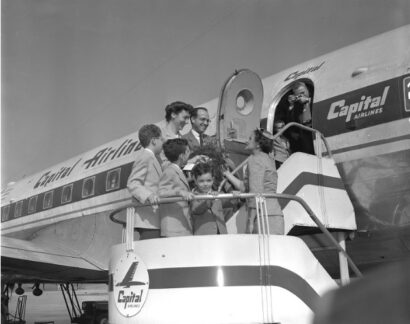
Dr. Jonas Salk with his family shortly after returning from the University of Michigan in Ann Arbor, where he announced the vaccine’s effectiveness. Credit: University of Pittsburgh Historic Photographs.
The polio years
A number of similarities exist between polio and COVID-19 eras. Many people who were infected with polio were asymptomatic and never became sick. Some developed mild, flu-like illness, usually with fever, sore throat and achiness, and recovered. In other cases, however, the disease progressed to severe symptoms, including very bad muscle cramps, weakness and paralysis within a week.
In the worst cases, polio resulted in death or lifelong paralysis inside an iron lung, a coffin-like respirator that took over breathing for an afflicted individual.
Like COVID-19, polio tended to spread in areas of higher population density. But unlike COVID-19, no one was certain how polio was transmitted. In addition to it potentially being airborne, like the spread of respiratory drops associated with the coronavirus, polio was also waterborne. As such, pools were off-limits for years, as were places like movie theaters.
If anything, anxiety for children was greater in the polio era than in the COVID-19 era because while polio could strike adults, it more typically struck young kids—most often those under 5. Parents feared letting children swim, go to movies and sometimes even play outside.
As in our time, the competition to produce an effective vaccine was fierce. While Salk labored at the University of Pittsburgh on a novel idea—a vaccine using killed poliovirus—a more senior researcher, Albert Sabin, also Jewish, raced at the University of Cincinnati to develop a vaccine using a live attenuated virus. Salk announced a viable vaccine first, and volunteer trials preceded a nationwide inoculation campaign. Trials took place in a number of locations across the United States, including Pittsburgh, the city where Salk conducted his research.
Several older Americans spoke about their recollections of taking part in these trials.
Marcia Weiss, now in her 70s, a retired attorney in Pittsburgh, was among the 1 million American children who participated in Salk’s early vaccine trials in 1954.
She recalled a “series of shots, injections and blood draws” that went on for “many months.”
Weiss’s father, a doctor, had heard about the vaccine trials “through the grapevine” and signed her up for them. It was important to him, she said, for his daughter, an only child, to take part, because he had so much faith in medical science.
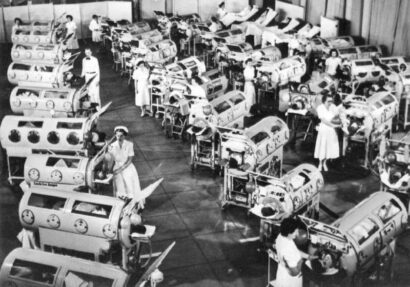
Children in Iron Lungs during the 1940s or 50s. Source: Rancho Los Amigos National Rehabilitation Center.
Parents were more frightened of polio in the 1940s and ’50s than kids, according to Weiss.
“I don’t remember being scared of polio, but at that time, kids were not allowed to go swimming,” she said. “We were very accepting. If our parents said, ‘You shouldn’t do this,’ we didn’t. It wasn’t scary for us, but I’m sure it was very scary for parents.”
But Weiss remembers seeing pictures of children in iron lungs. “That was scary,” she said.
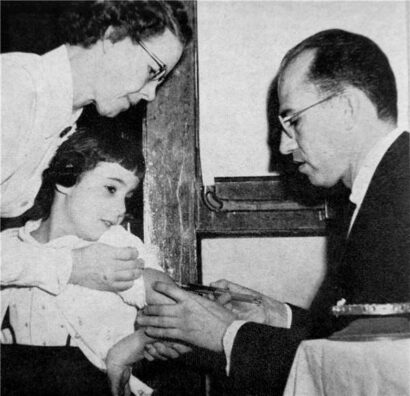
Dr. Jonas Salk vaccinates a child. Credit: Wikimedia Commons.
She remembered Salk coming over to talk with her father while her blood was being drawn, and that he sometimes drew her blood himself. She liked it when he did because he was “very gentle” and adept, she said, whereas technicians typically had trouble locating her veins.
Her father’s faith in the safety of the vaccine was bolstered, Weiss believes, by his awareness that Salk had early on administered the vaccine to himself, his wife and their three sons.
“I can still picture the headline in the paper when the vaccine was announced,” recalled Weiss. “I remember the big type, and thinking, ‘Oh, gee, I was part of this. This is wonderful.’ ”
Working in Salk’s lab
Gloria Rosen, 89, worked in Salk’s lab as part of his research team at the University of Pittsburgh. At the time, she was pursuing an undergraduate degree in toxicology at the university.
Rosen said she “dealt with [Salk] on a daily basis” in their work together, although she recalled he was “too busy to spend a lot of time with any one person.” She did, however, receive a letter of congratulations from him down the road after she adopted a daughter, Linda.
Later, Rosen adopted another daughter, Nina, who recalled that growing up, her mother stressed to her daughters that working for Salk had been a highlight of her life and career.
Salk was “selfless and completely devoted to what he was doing, and, of course, that’s why it got done,” said the octogenarian.
Rosen said men outnumbered women in the lab, although there were some other women. “I was perfectly happy to be able to do what I was doing and considered myself fortunate,” she recalled. “I didn’t have trouble with sexism. … Salk and his team were very professional.”
She described the work itself as fascinating, adding that “it’s very complicated what goes on in a lab.”
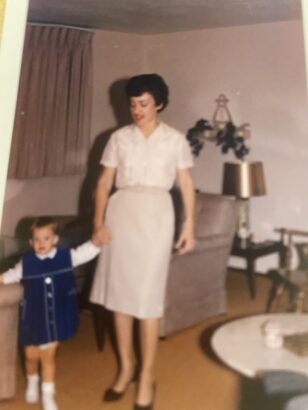
Gloria Rosen with her daughter Linda during the 1950s. Credit: Courtesy.
Once, her direct superior, an associate of Salk, told her to get some clean glassware out of a huge sterilizing machine called an autoclave. At the time, “I didn’t know any more about an autoclave than you do.”
An autoclave was like a tunnel with a tight cap on it that had to be opened under the right conditions (which, in this case, were not met). Fortunately, she said she was “smart enough” to stand behind the door when she opened it, “otherwise, I would’ve been killed when thousands of dollars of glassware shot out,” recounted Rosen.
Someone rushed to get Salk.
“He came running down the hall,” recalled Rosen. “He looked at me and said, ‘Gloria, don’t be upset. This also happened to one of the chimpanzees upstairs.’ I thought, ‘Why is Dr. Salk comparing me to a chimpanzee?’ I was in a daze. But he was making a joke. Thousands of dollars of glassware had been destroyed because I’d been misdirected. But he didn’t fire me.
“That was just one of my adventures.”
Of the polio years and her time with Salk, Rosen said she will never forget her sense that the work was of historic significance.
“It was very important work, and I was a part of it,” she said. “I was a late teenager, early 20’s, and Dr. Salk was very nice to me, so you can imagine how I felt.”
“I guess I was really lucky. … It was my pride and joy to work with Dr. Salk.”
Recollections of his father
Peter Salk, Jonas Salk’s eldest son, a part-time professor in the Department of Infectious Diseases and Microbiology at the University of Pittsburgh’s School of Public Health, and president of the Jonas Salk Legacy Foundation in La Jolla, Calif., revealed some personal memories of his father.
He also shared thoughts on how he believes his father’s legacy can guide modern medicine as it pertains to COVID-19.

Peter Salk receive a polio vaccination from his father, Dr. Jonas Salk. Credit: March of Dimes.
Asked if it’s true or apocryphal that his father was so completely focused that he slept in his laboratory to save precious moments in the race to develop the polio vaccine, Peter said, “I don’t think he slept in the lab, but he did stay late.”
While working on the vaccine during the early 1950s, Salk drove Peter each morning to his elementary school in Pittsburgh; the younger Salk said he treasures the memory of that rare alone time together.
Of the famous May 1953 photo of Salk preparing to administer the vaccine to his family, Peter Salk said his principal memory of the day is that when his father injected him, the needle—sterilized in a pot of boiling water on the kitchen stove—went in painlessly. But, he added, (echoing others interviewed for this piece) his father always had a nimble touch.
He believes that growing up in a culture, Judaism, that encouraged questioning might have played a role in shaping his father’s personality, which included his inclination to question. In a microbiology course in his first year of medical school, Jonas Salk challenged one of his professors about the established scientific orthodoxy that infection with the live virus is required in order to induce immunity.
“When the professor couldn’t come up with a good answer, my father became committed to exploring the possibility that a killed virus vaccine might, in fact, work,” said his son. “He became committed to exploring that question, and that is what led him to his work on the first influenza vaccine, and later, on the polio vaccine.”
A key difference between the polio era and this one is the unity of purpose, noted Peter Salk.
“In the polio years, the public was united, and all of my father’s work was 100 percent funded by the people of America through the March of Dimes,” he said. “So when the results of field trials came out and the vaccine was effective, it was the people’s victory.”
He stressed that his father was both a scientist and a humanitarian.
Jonas Salk was interested in “the problems that arise from man’s relationship to man,” he said, citing his father’s book, The Survival of the Wisest. He believes that his father would have viewed the pandemic as an opportunity for everyone to support medical science and vaccine development, and to work on “how we relate to each other in the way we come through this.”
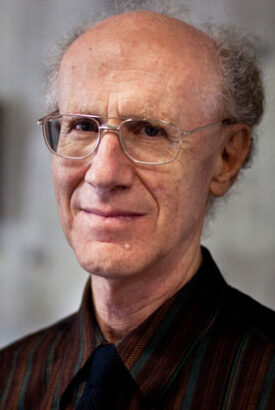
Peter Salk
The younger Salk said he strongly supports public-health measures like social distancing and mask-wearing. He added that ideally, public-health initiatives also allow for the airing of questions and concerns.
Salk echoed American immunologist Dr. Anthony Fauci, who has served as the director of the National Institute of Allergy and Infectious Diseases since 1984, who stressed the need for unity in how the world approaches this illness. Salk added, “The missing ingredient right now is cooperation and collaboration.”
“So however strong the feelings are—pro- or anti-vaccine, different opinions on masks—the more we can find common ground, the more we can begin to … pull together and harmonize our actions,” the faster he believes the world will succeed in overcoming COVID-19.
This entry was written by Heather Robinson and posted on August 21, 2020 at 12:36 pm and filed under Features. permalink. Follow any comments here with the RSS feed for this post. Keywords: . Post a comment or leave a trackback: Trackback URL. */?>



